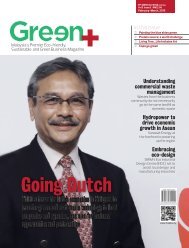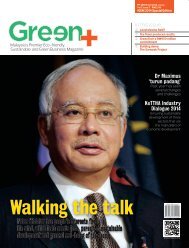Green+ Malaysia's Premier Eco-friendly, Sustainable and Green Business Magazine
SIRIM - Technology Provider
SIRIM - Technology Provider
You also want an ePaper? Increase the reach of your titles
YUMPU automatically turns print PDFs into web optimized ePapers that Google loves.
ENERGY<br />
energy loss due to distribution of energy<br />
through the grid.<br />
Chin indicated in The World PV<br />
Market scenario, at present in the<br />
beginning of 2014, Malaysia had<br />
100MW installed. It will have a cumulative<br />
capacity of 150MW (as at Sept<br />
2014) or 180GWh/year that is only<br />
0.17% of National Electricity Dem<strong>and</strong><br />
compared to the average Global<br />
indicators of 43.5GWp installed with<br />
cumulative 139GWp (2013) or 160TWh/<br />
year indicating a 0.85% usage of Global<br />
Electricity Dem<strong>and</strong>, whereby IEA forecasted<br />
growth to 11% of global electricity<br />
dem<strong>and</strong> by 2030.<br />
With 85% of Solar PV modules<br />
being manufactured (36GWp) in Asia,<br />
whereby China <strong>and</strong> Taiwan are the<br />
major producers, Malaysia is still contributing<br />
about ~3,800MWp (approx.<br />
10.5% ). It is perceived that Malaysia<br />
should also take a lead in PV installations<br />
<strong>and</strong> benefit from Solar energy as<br />
one of the major producing countries<br />
in Asia.<br />
The Malaysian Photovoltaic Industry<br />
Association would like to suggest the<br />
following:-<br />
NET Energy Metering (NEM)-Allow<br />
the Commercial <strong>and</strong> Industrial players<br />
to produce their own electricity but<br />
using the NEM methodology to have<br />
independence <strong>and</strong> security of energy<br />
supply.<br />
The idea of net metering came<br />
about as electricity generation from<br />
RE resources by users has become<br />
more competitive compared with that<br />
from conventional fuels (mainly coal<br />
<strong>and</strong> gas). The most important of these<br />
initiatives have been the growing competitiveness<br />
of grid-connected solar<br />
PV systems, although other renewable<br />
energy sources such as biogas, biomass<br />
<strong>and</strong> small to mini-hydro can also<br />
qualify.<br />
PV is a rapidly growing RE resource<br />
due to its substantial <strong>and</strong> sustained cost<br />
reduction over the years resulting from<br />
its production volume “explosion” <strong>and</strong><br />
technology development. PV provides<br />
the option of a “clean, green & indigenous”<br />
source of electricity generation,<br />
with virtually unlimited generation<br />
capacity. It also has the advantage of<br />
generating its output during the<br />
national system peak dem<strong>and</strong> period,<br />
just when it is most needed <strong>and</strong> most<br />
costly to generate from conventional<br />
generation sources like Open Cycle Gas<br />
Turbines (OCGTs).<br />
In the Malaysian context, Net Energy<br />
Metering (NEM) has now become a very<br />
viable option to complement (or even<br />
displace) the current Feed-in-Tariff<br />
(FiT) mechanism as the latter is seen<br />
as an undesirable (<strong>and</strong> even socially<br />
Proposed Strategies <strong>and</strong> Future PV<br />
L<strong>and</strong>scape for Malaysia<br />
Commercial <strong>and</strong> Industry - NET ENERGY METERING (2015 – 2025)<br />
2015-2020 - With Investment Tax Allowance (1.75GW)<br />
2021-2025 - Without Investment Tax Allowance (5 GW)<br />
2026-2035 - Without Investment Tax Allowance (22.4 GW)<br />
Extension of FIT +NEM – Individual/Residential Quota Only (2016-2025)<br />
2016-2025 – 10 years Power Purchase Agreement (1.65GW) - 200,000 rooftops<br />
2026-2035 – Net Energy Meter ( 8.45GW) – 1,000,000 rooftops<br />
PV Utility Scale Installation - Future<br />
unjust) burden on the electricity consumers who have<br />
to pay for the FiT’s “top-up” tariff. Moreover, the RE Fund<br />
levy limitation constrains more rapid expansion of the PV<br />
market due to the limitations of available fund from the 1.6%<br />
levy imposed on the affected electricity customers. These<br />
are contributions from consumers.<br />
The NEM scheme would give greater opportunities to<br />
the consumers concerned to generate their own electricity<br />
from RE resources, especially solar PV for their own<br />
consumption thereby hedging against any future tariff<br />
increase.<br />
MPIA also proposed strategies <strong>and</strong> future PV l<strong>and</strong>scape<br />
for Malaysia for Commercial <strong>and</strong> Industrial market with<br />
NET Energy Metering including FIT + NEM for individual<br />
/Residential installations as per above self explanatory<br />
diagram.<br />
Utilities may perceive NEM as a major threat but it could<br />
actually benefit all parties –from the energy users or customers<br />
to the utilities <strong>and</strong> the country as a whole.<br />
Guiding Principles for Net Energy Metering (NEM)<br />
The following guiding principles should be considered for<br />
the adoption of the NEM mechanism:-<br />
Self-Generation <strong>and</strong> Access to the<br />
Utility Grid: Qualified retail electricity<br />
customers should have the right<br />
to install RE generation facilities<br />
such as rooftop solar PV systems<br />
at their premises <strong>and</strong> connect<br />
them to the utility grid without any<br />
discrimination.<br />
Value of Solar PV generated<br />
Electricity: Rooftop owners of solar<br />
PV generation systems can offer<br />
many benefits to the electricity<br />
supply system <strong>and</strong> the nation. These<br />
include:-<br />
➲ Reduction in utility capacity <strong>and</strong><br />
energy generation requirements,<br />
especially during the peak dem<strong>and</strong><br />
period that coincides with the PV<br />
generation profile.<br />
➲ Reduction in distribution<br />
system losses.<br />
➲ Avoidance or deferral of distribution<br />
<strong>and</strong> transmission system<br />
reinforcement investments.<br />
➲ Hedging against fuel price volatility<br />
especially for imported fossil<br />
fuels.<br />
➲ Reduction in greenhouse gas<br />
emissions <strong>and</strong> water usage.<br />
These benefits should be quantified<br />
to determine the true value of solar PV<br />
generated energy delivered to the grid.<br />
Capacity Limit on Rooftop PV<br />
Installations: No capacity limit should<br />
be imposed on the total rooftop PV generation<br />
as it forms “generation at point<br />
of use” <strong>and</strong> is a valuable addition to the<br />
national electricity generation fuel mix.<br />
However, the terms <strong>and</strong> conditions can<br />
be considered for NEM applicable as<br />
follows with a proposed NO QUOTA<br />
LIMIT :-<br />
➲ Maximum Installation capacity:<br />
18<br />
november-december, green+.2014





